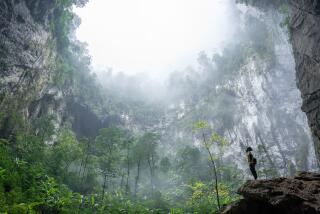Cave exploring leads to discovery of Holocaust survival story
- Share via
Twenty years ago, veteran caver Chris Nicola received an offer from a Ukrainian friend to explore the well-known gypsum giant caves in the western part of the European country.
Nicola quickly accepted the invitation.
“My family on my mother’s side had Cossack roots and they were known to come from the Ukraine,” the New Yorker said over the phone this week. “I thought in the back of my mind I could do some family research.”
But his main reason was to visit the 77-mile long Priest’s Grotto cave, which is part of an extensive gypsum cave system.
ON LOCATION: People and places behind the movies
“I was looking forward to seeing the major passages and cave formations I had read about,” he said. “They were known to cavers worldwide because gypsum caves do not occur frequently in nature. They tend to be extremely large, and some formations are just beautiful.”
Besides encountering stunning formations, however, he also found “bits and pieces of shoes, broken glass, trenches, table tops made out of earth and benches to sit on.”
A senior investigator with the state of New York, Nicola put on his investigator’s hat once he was back on the surface. He learned from farmers and older residents of a rumor that Jews hid from the Nazis in the caves during the Holocaust.
“No Place on Earth,” a documentary directed by Janet Tobias that opened here Friday, chronicles Nicola’s search to discover whether the rumor was true.
What he found was an extraordinary tale of love, strength, bravery and the quick thinking of an amazing matriarch, Esther Stermer, who knew that if her family didn’t try to escape their village, they would end up arrested and sent to live in concentration camps. The caves seemed to be their only option. So in October 1942, the Stermers, the Wexlers and other families literally went underground and spent more than 500 days there — first in the smaller Verteba Cave and then the Priest’s Grotto — until the Russians liberated the area.
Thirty-eight people survived the ordeal, 12 of whom are still living.
Nicola finally got in touch with the survivors in 2002 after he’d come across a sophisticated Jewish genealogical website.
PHOTOS: Hollywood Backlot moments
“I realized every day there were thousands of Jews all over the world going to this site,” said Nicola, who is not Jewish.
“I thought if there were Jews living in the cave and they’d survived, perhaps one day there would be relatives searching out their families,” he said.
Nicola decided to embed key words into his own website about Ukrainian caves, hoping that “maybe someone would find their way to tell me the rumors were true.”
In December that year, he received an email from a man who said his father-in-law, Sol Wexler, had survived the Holocaust in the caves.
“I found he was living less than seven miles away,” Nicola said.
Sixty-seven years after they emerged from the caves, four of the survivors — Saul Stermer, Sam Stermer, Sonia Dodyk and Simoa Dodyk – returned to them with Nicola for the documentary.
It was an amazing experience, he said.
“I felt like I was looking at [the caves] through their eyes,” said Nicola, who wrote a young adult book in 2007 with photographer Peter Lane Taylor, “The Secret of Priest’s Grotto: A Holocaust Survival Story.”
“They were seeing things just the way they saw them 67 years ago,” he noted.
PHOTOS AND MORE
Roger Ebert: Career in pictures
ENVELOPE: The latest awards buzz
PHOTOS: Greatest box office flops
More to Read
Only good movies
Get the Indie Focus newsletter, Mark Olsen's weekly guide to the world of cinema.
You may occasionally receive promotional content from the Los Angeles Times.











